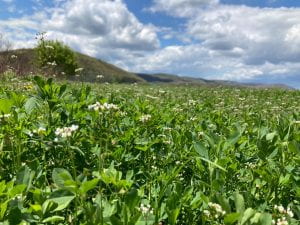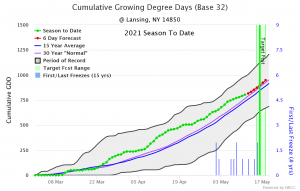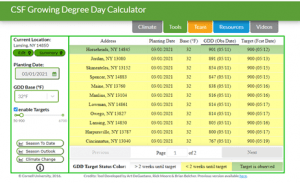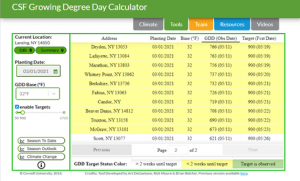This is the SCNY Team’s second full week of monitoring alfalfa heights for first cutting quality in 2021. A full report for the six-county region can be found in the following link: Alfalfa Height Reporting Sheet 5.11.2021
What a Slow Week!
Compared to last week, alfalfa grew much more slowly. On average, across most locations, alfalfa grew 2-2.5″, with the exception of Tompkins County, which averaged about 4″ of alfalfa growth. In looking at our measurements this week, locations and heights are all over the board. Many locations have approached or are past peak grass quality harvest. The best strategy for determining your field conditions is to visually assess what’s going on out there!
Dynamic Harvest Scheduling
Again, I want to reiterate – conditions out there are quite soggy, as we’ve gotten over 2″ of rain in the past two weeks. Warmth in the forecast may make grass jump and gain maturity pretty quickly. Evaluating the fields you have to harvest along with legume content in those fields will give you a starting point for deciding to leave some grass fields for heifer/dry cow feed and tackling higher legume fields for lactating quality. Check out the article on Dynamic Harvest Scheduling – the best results can come from being flexible in your harvest sequence and harvesting fields when the forage is at the target quality.
Growing Degree Days
Looking at GDD (B32), on average, locations tracked using Cornell’s Climate Smart Farming Growing Degree Day Calculator showed about 100 GDD gain. With this cool weather, we are no longer trending above “normal” in most locations, and are pretty much “average” for this time of year. Lansing, who I’ve been tracking through the spring, gained 127 GDD (B32) since last week, which may not tell the whole story for growth we measured in Tompkins County this week. GDD are a nice proxy to check out what temperature has been doing in different locations, but alfalfa height is the best determinate of the correct timing for harvesting forage for dairy quality feed.
Why Use Alfalfa Height for Prediction?
We utilize alfalfa heights for targeting peak quality of all fields, as research as shown it to be the best indicator of peak quality.
As a reminder, for prediction of NDF content, the height of alfalfa as an indicator is as follows:
- 100% grass stands – cut when nearby alfalfa is 14 inches tall (achieves 50% NDF)
- 50/50 grass/alfalfa stands – cut when nearby alfalfa is 22 inches tall (achieves 44% NDF)
- 100% alfalfa stands – cut when alfalfa is 28 inches tall (achieve 40% NDF)

Predicted days to cut are based on daily NDF increases for grasses of 1.0% point, 50/50 mixed alfalfa/grass stands of 0.8% points, and alfalfa of 0.5% points and are adjusted for the coming week’s weather. Typically NDF increases about 0.8 to 1.2 per day for grasses, with cooler weather being the lower end of the range and warmer weather being the higher end. For alfalfa, NDF increases about 0.4 to 0.7 per day, also dependent upon warm/cool weather.
Next Report …
Look for our next report of monitoring heights to come out on Wednesday, May 19th. In the meanwhile, if you can’t get out to check your fields, call one of us on the team. We’ll be glad to help out.
I’m also interested in hearing if you harvested any cover crops – let me know date you harvested, and any feed samples you may have taken!
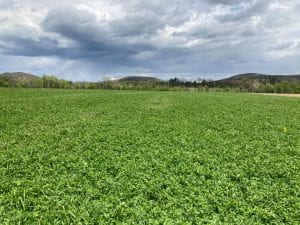
Donette Griffith, Liz Alexander, Dana Havas, Jenny Smith, Dave Skeval, Mary Kate MacKenzie & Fay Benson
THANK YOU!

